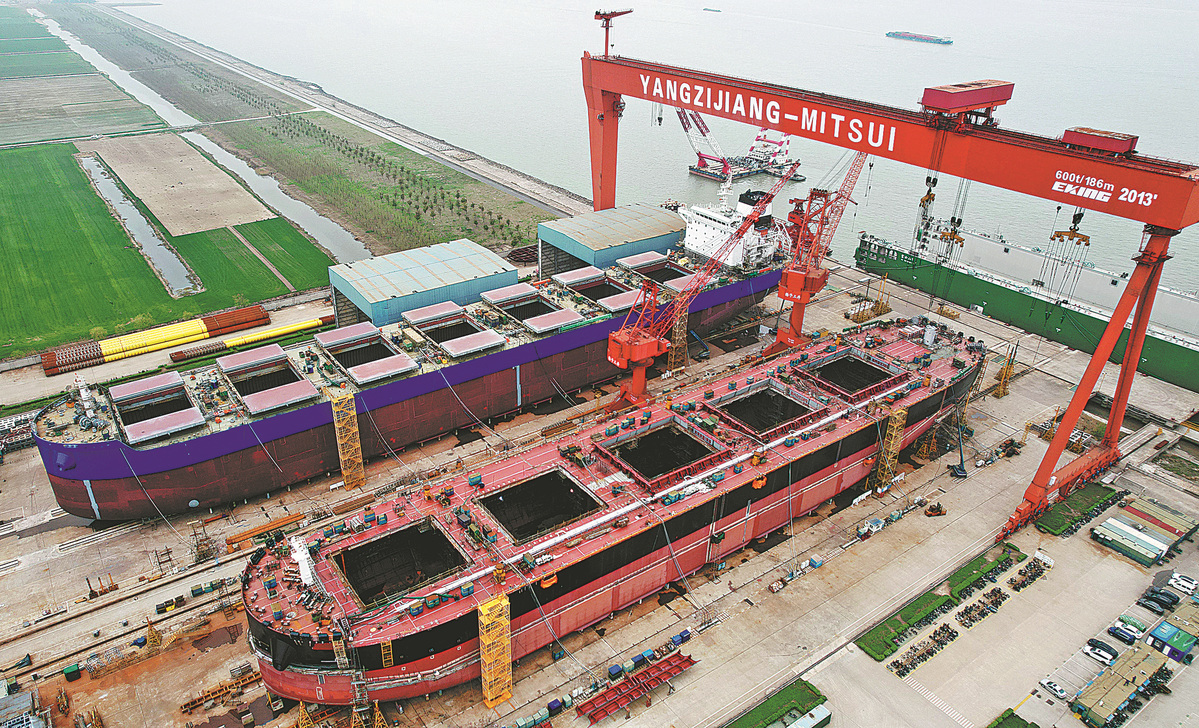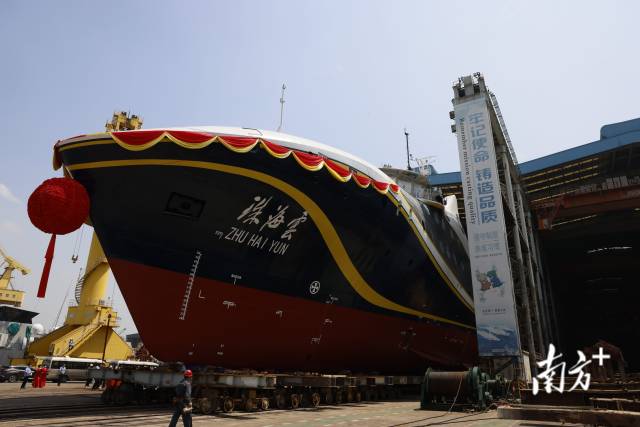Shipbuilders to witness fast growth on soaring demand
By ZHONG NAN | China Daily | Updated: 2022-05-17 09:35
An aerial view of a shipbuilding yard in Taicang, Jiangsu province, in March. [JI HAIXIN/FOR CHINA DAILY]
Global push in reducing CO2 brings more orders for even greener vessels
China's shipbuilding industry will enter a high-growth period this year, driven by the soaring demand of foreign shipowners, and their moves to adopt new vessels with green and high-efficiency engines to meet international demand for lower carbon emissions, said industry officials and shipbuilders.
The country's shipbuilders saw holding orders soar 26.3 percent on a yearly basis to 99.1 million dead weight tons in the first quarter of this year, accounting for 47.3 percent of the world's total, data from Beijing-based China Association of the National Shipbuilding Industry (CANSI) showed.
He Minghui, assistant president of Jingjiang, Jiangsu province-based Yangzijiang Shipbuilding Group, said the company's holding orders have reached the highest level in nearly two decades, with about 90 percent of orders placed by foreign clients, mainly from Japan, Singapore and a number of European countries.
The company, supported by more than 6,000 employees, currently holds more than 140 orders or about 11 million DWTs. These vessels, mainly container and bulk ships, will be delivered to their domestic and overseas buyers between 2022 and 2024.
Yang Qiang, deputy head of Jingjiang Customs, a branch of Nanjing Customs, said shipbuilders in Jingjiang had delivered 18 vessels, including oil tankers and container ships between January and March of 2022, surging 12.5 percent from the same period last year.
In March alone, manufacturers in Guangdong province, another manufacturing base for China's shipbuilding industry, exported 69 vessels to countries including the United States, Germany and Spain, jumping 102.9 percent on a yearly basis, while their value grew by 77.3 percent on a yearly basis to 1.28 billion yuan ($190 million), according to Guangzhou Customs.
Tan Naifen, deputy secretary-general of CANSI, said the growing shipping demand and rising freight rates have significantly bolstered both revenue and profit growth of global shipping and energy companies, such as France's CMA CGM SA, Denmark's Maersk Line and QatarEnergy, formerly known as Qatar Petroleum, over the past two years.
"Many of them have accelerated the pace of phasing out their aged ships with high fuel emissions and buying new advanced vessels to meet specifications required by the United Nation's international maritime organization to cut carbon emission in the global shipping business," she said. "Therefore, shipping companies must replace aging ships. Dual-fuel engines, and engines powered by liquefied natural gas and liquefied petroleum gas, have become popular choices for global shipowners."
With a dual-fuel engine, the ship can use liquefied natural gas and regular fuel to convert chemical energy into mechanical energy.
Moreover, Chinese companies, including Shanghai-based CSSC's Hudong-Zhonghua Shipbuilding (Group) Co Ltd and Jiangnan Shipyard (Group) Co Ltd, gained 17 orders for building LNG tankers, each able to hold 174,000 cubic meters of LNG, for global customers, mainly from Qatar and the United Arab Emirates, by the end of April this year, according to CANSI data.
Chen Yajun, head of the sales department at New Times Shipbuilding Co Ltd, another Jingjiang, Jiangsu province-based shipbuilder and exporter, said the company's production plan for dual-fuel engine-powered ships till 2026 has been scheduled, including building a 210,000 DWT bulk carrier, 8,000 and 11,000 TEU (twenty-foot equivalent unit) ships.
CANSI data showed that China's new shipbuilding orders for green and high-efficiency engine-powered ships have surged from 24.4 percent in 2021 to 31.7 percent in the first quarter of this year, thanks to the explosive growth of the international shipping market in the past two years and the industry's efforts to further cut greenhouse gas emission.
However, Mao Jian, deputy head of the material supply department at New Times Shipbuilding, said the company is facing pressure in obtaining supplies of marine paint, as many related manufacturers in Zhejiang and Jiangsu provinces are having difficulties in resuming production at full capacity.
Sections for nearly 20 ships still need to be painted, and the issue of getting sufficient marine paint and other industrial parts has delayed production in recent months, he said, pointing out that this will affect the company's schedules for launching new ships and their delivery to foreign customers.
The price of a truck of marine paint has soared from around 3,500 yuan in 2020 to between 15,000 yuan and 18,000 yuan this month, and it is difficult to find enough truck drivers to transport them to the shipyards, due to COVID-19.


